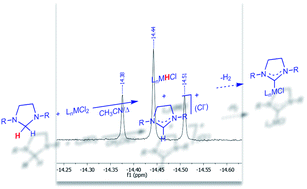Imidazolidines as hydride sources for the formation of late transition-metal monohydrides†
Abstract
The reaction of a series of imidazolidines with chloro-complexes of Ir, Rh and Ru affords the clean generation of the corresponding monohydrido metal species. Computational analysis of the reduction process suggests that the reaction proceeds via imidazolidine coordination followed by β-hydride elimination, affording the metal hydride and the imidazolinium cation as the only reaction products. The application of imidazolidines for reduction of transition-metal halides represents a principally new method for selective generation of monohydrides. No over-reduction takes place even when using a large excess of the imidazolidine.


 Please wait while we load your content...
Please wait while we load your content...